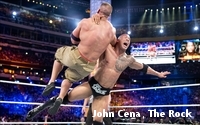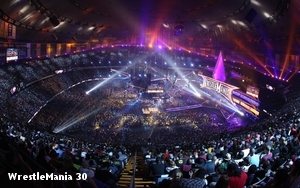 The WWE Network is the greatest thing I’ve ever seen.
The WWE Network is the greatest thing I’ve ever seen.Okay, that overstates
the case a bit. So how about: Assessed in the broader context of human experience, the WWE Network ranks behind sunlight, indoor plumbing and relaxed-fit pantswear. But as a detail-attentive
leveraging of an established media property’s past and current content, it sets the standard for everything to follow. It feels like the future. A few years from now, we’re going to look
back on its debut as the first shot fired in a revolution.
I say this as a lapsed wrestling fan and a middle-aged dude who, for some time, had been set
in his media-consumption ways. Most nights, I tucked in my son, fetched myself a snifter of Cocoa Puffs and watched whatever happened to be on TV, which I managed with a small device configured to
operate electronic equipment from a distance (a “remote control,” if you will). There was, and is, comfort in this routine.
So when WWE
announced the rollout of its streaming-only network back in January, I couldn’t help but notice a word that was missing from the introductory press release: television. One can watch the WWE
Network on iOS and Android devices and via PlayStations 3 and 4, Xbox 360, Roku and Apple TV. One can even watch it on oh-so-passé computer machines. One cannot, however, turn on the television
and find WWE Network anywhere on the cable dial.
In theory, this approach sounds almost willfully disruptive and self-sabotaging. A 24/7 television-like
network that isn’t on TV? Lay off the basement hooch, Junior.
In practice, however, it sings. The content -- more on that in a bit -- begs the
thesaurus to come up with a stronger word for “encyclopedic.” The video quality is on par with anything you’ll see on television. The technology, built in conjunction with the folks
at MLB Advanced Media… well, the technology works, which is more than can be said for many similar online plays. Taken together, these attributes render the WWE Network precisely the type of
property that could prompt luddites and/or lazy asses to drag themselves into the multiscreen era.
Which isn’t to say that the WWE is relying on
laggards to make the network a success. According to WWE chief revenue and marketing officer Michelle Wilson, the company did loads of research prior to cementing plans for the network. It learned
that its core fans consume five times as much video content online as the average consumer and are twice as likely to have a subscription to Netflix or other streaming service. “The light bulb
went on,” she says.
Thus was born the online network/library hybrid. With an eye on one day creating a wrestling channel of some kind, WWE had
years ago snapped up the tape libraries of now-defunct competitors and set about digitizing them. What this means is that the network came into being with more than 130,000 hours of content to play
with, everything from old pay-per-views to this week’s WWE Raw. From that content it can create new programming like WWE Countdown, which lets viewers debate/celebrate the best wrestler entrances, finishing moves and
catchphrases. On Thursday night, it rolled out WWE Legends’ House, which is everything its name implies and, yet, somehow more.
“I’d say we have the content area covered,” Wilson quips.
Did I describe myself before as a lapsed fan? Much to the great joy of my
wife, a few days with the WWE Network reawakened my latent fandom and birthed a new disciple in our kid. This has less to do with the regular programming than it does the copious amount of material in
the library, and the wonderfully intuitive way it is organized and indexed. You can search by wrestler or by event. You can track down the matches and segments you remember fondly from your youth, and disappear down the rabbit hole for hours.
“We really pushed ourselves with things like milestone markers -- like being able to skip ahead to the Rock/Cena match at WrestleMania 29. The goal was to launch with something that was easy to use,” Wilson
says.
Separately, for those who have been away for a while, it’s striking how different the modern-day WWE product -- all color and volume and
bombast -- looks when viewed next to the long-ago footage of dimly lit hulks in unflattering tights. Also, Cesaro? Get a strap on that fella.
When asked who else could create a network of
this kind, Wilson declines to speculate. “I’m not sure, to be honest. The WWE is unique. We’re content creators and we control our intellectual property.” But any of the sports
leagues, even the ones with preexisting cable/satellite channels, could pull off something similar, no? The mere possibility of adding a searchable game/play/player archive to my MLB Extra Innings
package makes me dizzy with anticipation.
League commissioners and their media underlings have to be watching the WWE Network, scratching their chins
pensively and thinking to themselves, “Cut out the middleman, eh?” I’d think the unspoken threat of that alone could make negotiations with cable/satellite providers and other
would-be media partners slightly more interesting.
But what do I know? I’m just some guy who spent the last three hours of his time-limited adult
life watching Mr. Perfect matches. I can safely say this, however: If you’re a WWE fan, you owe it to yourself to check
out the WWE Network. If you’re intere sted in the future of media, particularly as it pertains to high-profile properties, you owe it to yourself to check out the WWE Network.
sted in the future of media, particularly as it pertains to high-profile properties, you owe it to yourself to check out the WWE Network.
I have no clue whether the network will prove a winner from a financial standpoint -- WWE stock took a hit after the company reported 667,287 subscribers on April 7,
the day after WrestleMania 30 -- nor whether it can keep casual fans on board past the initial six-month subscription period. But in terms of doing right by its fans, WWE couldn’t have come out
of the gate any stronger. More than any new property in years, the WWE Network bears close watching.